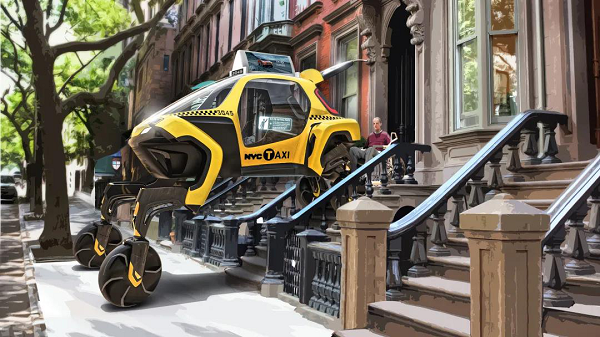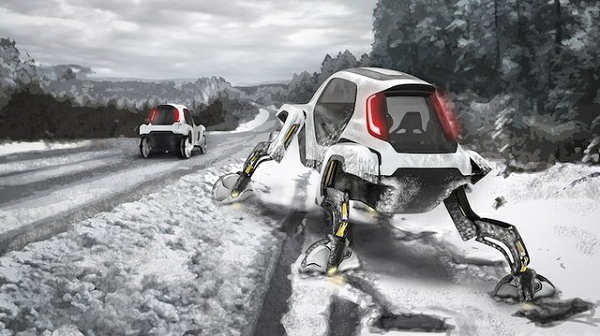
At this year's all-digital Autodesk University event, the Design & Manufacturing Keynote centred on 'Elevate', a new vehicle concept from Hyundai, which is employing generative design technology to develop a new vehicle that has the ability to "walk" in challenging environments.
在今年的Autodesk University数字化活动中,设计与制造主题演讲围绕着"Elevate "展开,这是现代汽车(Hyundai)推出的一款新概念汽车。它采用了欧特克衍生式设计技术,开发出一款能够在具有挑战性环境中 "步行 "的新型新车。
Debuted at last year's CES by the automotive manufacturer's New Horizons Studio in collaboration with industrial design studio Sundberg-Ferar, 'Elevate' is a four-legged vehicle which can alternate between driving and "walking" functions depending on the terrain or application, providing a mobility solution for various transport needs, exploration and emergency scenarios.
在去年消费电子展(以下简称:CES)上,由汽车制造商新视野号(New Horizons)工作室与工业设计工作室Sundberg-Ferar(一家工业设计咨询公司)合作推出的 "Elevate "是一款拥有四条腿的车,它可以根据不同的地形情况在驾驶和 "步行 "功能之间交替,为各种交通需求、探索和应急场景提供解决方案。
Here, Andy Harris (AH), Senior Principal Research Engineer at Autodesk Research, talks to TCT about how generative design is making this unique "Transformer" style vehicle possible.
在这里,欧特克研究部高级首席研究工程师Andy Harris(AH)向TCT团队讲述了衍生式设计是如何让这种独特的 "变形金刚 "式的汽车成为可能。
TCT: At AU, Hyundai is presented the latest iteration of its “walking car”, designed using Autodesk tools - can you tell us how this collaboration emerged?
TCT:现代汽车展示了通过使用欧特克工具设计的最新型的 "步行车 "产品,您能告诉我们这次合作是如何产生的吗?
AH: After debuting the walking “Elevate” concept vehicle at CES 2019, John Suh – founding director of Hyundai's New Horizons Studio in Silicon Valley – began exploring how the vehicle could become a reality. It is a unique mobility solution with immensely difficult design and engineering challenges, but also very promising potential applications that are worth pursuing. One of the most common is the transportation industry’s quest to create components that are lighter, but stronger, than past generations of similar components.
AH:在CES 2019上首次亮相"Elevate "概念车后,现代汽车位于硅谷的新视野号工作室的创始人John Suh开始探索如何实现该车。这是一种独特的移动解决方案,具有极大的设计难度和工程挑战,但也有非常有前途的潜在应用,值得探索。
Designers and engineers tasked with these “lightweighting” challenges frequently look to futuristic materials such as metallic foams, carbon fiber and new metal alloys – along with modern design techniques such as generative design – for solutions. These are areas where Autodesk’s tools and expertise excel, so Hyundai turned to Autodesk for input.
肩负这些 "轻量化 "挑战的设计师和工程师经常会寻找金属泡沫、碳纤维和新型金属合金等未来材料以及衍生式设计等现代设计技术寻求解决方案。现代汽车之所以找到欧特克,因为这都是欧特克的专业技术擅长的领域。
TCT: What were the main goals of the concept in terms of its design and functionality?
TCT:在设计和功能方面,这个概念的主要目标是什么?
AH: The Hyundai Elevate Ultimate Vehicle (UMV) was inspired by the "transformative" characters in the "Transformer" series. The concept vehicle – developed using Autodesk’s generative design technology in Fusion 360 – explores the possibility of transforming from a four-wheeled vehicle into a four-legged, walking vehicle that offers flexibility to navigate irregular terrain and places where there are no roads, which is especially useful in emergency rescue situations, as well as when exploring on Earth (and potentially other planets).
AH:现代提升终极汽车(UMV)的灵感来自“变形金刚”系列中的“变形”角色。使用欧特克Fusion 360中的衍生式设计技术,探索了将四轮车变成为四条腿步行车的可能性,它可以灵活地在不规则地形和没有公路的地方步行。尤其在紧急救援、以及在地球上(可能还有其他星球)探索时特别有用。
In addition, Hyundai Elevate UMV was created to help people with disabilities get around more easily. Autodesk’s Generative design technology helped Hyundai uncover solutions for some of the most challenging components of the product concept, including strong, rigid and light designs, while ensuring outstanding compactness.
此外,现代Elevate UMV的诞生是为了帮助残障人士更方便地出行。欧特克的 "衍生式设计 "技术帮助现代汽车确保出色的紧凑性同时,也为产品概念中最具挑战性的部分找到了解决方案,其中包括坚固、刚性和轻量化设计。
TCT: The vehicle has been described as the “ultimate mobility vehicle” - how challenging was it to incorporate that “Transformer” element into the vehicle design?
TCT:这款车被称为 "终极机动车",将 "变形金刚 "元素融入到车辆设计中有多大的挑战性?
AH: The challenges of this category of vehicle span a number of different aspects of engineering, from how the vehicle is powered and the motors that drive it – so it gets where it’s intended to go – to how it’s controlled and that doing so is intuitive, thus increasing the vehicle’s safety and utility.
AH:这类车辆的挑战涉及到多个不同方面的工程,从如何为车辆提供动力和电机驱动,使其到达预定目的地,到如何控制车辆。这样做是易懂的,从而提高车辆的安全性和实用性。
In many cases, one design requirement or element of the concept creates multiple significant engineering challenges to overcome. For instance, an electric vehicle (EV) that both drives and walks appears best executed by placing a powerful, high-torque electric motor at each wheel (for driving). But to walk safely and effectively requires the “legs” to be very strong, rigid and jointed, and the whole assembly (including the motor-containing “feet”) to be very light. That is not a simple set of engineering requirements to solve.
在许多情况下,一个设计需求或概念元素会产生多个重大的工程挑战需要克服。例如,一个既能驱动又能步行的电动车(EV),最好运行方式是在每个车轮(用于驱动)上安装一个强大的高扭矩电动马达。但是,要想安全有效,"腿 "必须坚固、硬度大、连接性强,而且整个组件(包括含有马达的 "脚")必须非常轻便。这可不是一套简单的工程要求就能解决的。

Hyundai 'Elevate' Walking Car Concept.
现代 "Elevate "概念步行车。
TCT: The automotive industry has undergone a lot of change with the advent of electronic and autonomous vehicle technologies - how are technologies like generative design helping to facilitate that change?
TCT:随着电子和自动驾驶汽车技术的出现,汽车行业发生了很多变化,像衍生式设计这样的技术是如何帮助促进这种变化的?
AH: According to the Harwell-based Faraday Institution, the UK will need to launch its first full-scale gigafactory for battery production to cope with the surge in EV demand over the next three years. The research institute is backed by the government to ensure a steady supply of batteries in the future.
AH:根据总部位于哈韦尔(Harwell)的Faraday Institution的说法,英国将需要建立第一个全面的电池生产巨型工厂,以应对未来三年电动车需求的激增。该研究机构得到了政府的支持,以确保未来电池的稳定供应。
However, simply producing more batteries isn’t enough to electrify transportation and eliminate emissions. Achieving these results will also require a redesign of the car’s components. An electric vehicle comes with a whole set of new challenges.
然而,仅仅生产更多的电池还不足以实现交通电动化和减少排放。要实现,还需要重新设计汽车的零部件。电动汽车从而带来了一系列新的挑战。
There are conflicting considerations: Mileage and battery weight; safety and lightweight, and customer experience and affordability. One tremendously valuable way of addressing these conflicts is to break from traditional workflows and include technology such as artificial intelligence (AI) that assists designers and engineers in their process of finding the best solutions.
有一些相互矛盾的问题需要考虑,里程和电池重量;安全性和轻量化;客户体验和经济性。解决这些问题有一个非常有价值的方法,就是打破传统的工作流程,加入人工智能(AI)等技术,在过程中协助设计师和工程师寻找最佳解决方案。
Generative design offers vehicle manufacturers a new, but proven, tool to reduce weight, increase fuel economy and often improve performance by designing components using a variety of lightweight, recyclable materials, such as aluminium, magnesium, or PLA plastics. Generative design often enables manufacturers to consolidate assemblies into fewer parts by suggesting design solutions that are beyond what a team may have thought it had the time or resources to consider.
衍生式设计为汽车制造商提供了一种新的且已经验证过的工具,并通过使用各种轻质、可回收材料(如铝、镁或PLA塑料)设计零件,以减轻重量,提高燃油经济性和改善性能。衍生式设计往往能使制造商通过提出超出团队可能认为有时间或资源考虑的设计方案,将组装件合并成更少的零件。
Advanced lightweighting approaches through generative design will be pivotal to improving power consumption and the range of electric vehicles, while different materials and compositions will improve the structure of electric cars. A circular approach (a closed-up system that doesn’t generate waste), has huge potential in an industry like automotive, where manufacturers have the power to impact the entire design and manufacturing approach, creating a workflow that favours recycling and closed-loop manufacturing.
通过衍生式设计的先进轻量化方法将对提高电动车的功耗和续航里程起到关键作用,而不同的材料和成分将改善电动车的结构。循环方法(一个不产生废物的封闭式系统)在汽车这样的行业中具有巨大潜力,制造商有能力影响整个设计和制造方法,创造一个有利于回收和闭环制造的工作流程。
TCT: As we’ve seen from previous Autodesk collaborations with the likes of Volkswagen and BAC, generative design can open up very some unique design possibilities - how open minded has Hyundai been in exploring those ideas which would have previously been considered unconventional for the automotive industry?
TCT:正如我们从之前欧特克与大众、布里格斯汽车公司(BAC)等公司的合作中可以看到,衍生式设计可以开辟出一些非常独特的设计可能性。现代在探索那些以前被认为是汽车行业非传统的想法方面有多开放?
AH: Something the team at Autodesk has come to deeply appreciate, because it truly expands what’s possible, is Dr. Suh’s team at Hyundai’s New Horizons Studios being both very visionary and experimental, as well as very pragmatic. This entire project is unconventional, so from the start it requires people to think beyond “what is” to instead think in terms of “what if?”. That said, the follow-on question after the “what if?” has consistently been “how will we?” and exploring how to make the vision a practical, affordable, conventionally-manufactured reality.
AH:欧特克团队非常欣赏的一点是,现代汽车的新视野工作室的Suh博士的团队非常有远见和实验性,同时也非常务实。整个项目都是非传统的,所以从一开始就要求大家超越 "是什么",而是从 "如果 "的角度去思考。也就是说,在 "如果?"之后的后续问题始终是 "我们将如何?",并探索如何将这一愿景成为实际的、负担得起的、常规制造的现实。
TCT: We know generative design complements technologies like additive manufacturing - can you talk to us about the manufacturing processes being employed by Hyundai?
TCT:我们知道衍生式设计与增材制造等技术相辅相成,您能和我们谈谈现代汽车采用的制造工艺吗?
AH: Generative design also guides us in determining how the necessary parts should be manufactured. Many examples have showcase applications of generative designs that are best produced by 3D printing the parts. We did look at this for prototyping with Hyundai. In order to align the output within the company's existing manufacturing methods, we changed the generative design algorithms to only explore options that would fit into Hyundai’s existing methods.
AH:衍生式设计还指导我们确定如何制造必要的零件。许多例子都展示了由3D打印零件产生的最佳衍生式设计的应用。我们在现代汽车的原型设计中研究过这个问题。为了使输出与公司现有的制造方法相一致,我们改变了衍生式设计算法,适合探索现代汽车现有方法的选项。
As we went through iterations of the possible outcomes, Hyundai had a clear view of how the designs fit with the more conventional manufacturing machines and processes that exist within its supply chain, and thus was able to ensure the final suggested output could be made using those methods.
当我们对可能的结果进行迭代时,现代汽车清楚地看到了这些设计与其供应链中存在的较为传统的制造机器和流程的契合度,从而能够确保使用这些方法可以做出最终建议的输出。
TCT: For future facing vehicle concepts like this, do you think it’s important for manufacturers to start incorporating new and exciting technologies from the off-set, like generative or AM for example, in order to help facilitate a wider shift towards adopting these more ‘non traditional’ manufacturing designs and techniques more regularly?
TCT:您认为对于制造商来说,面对未来的汽车概念时,从一开始就采用新颖且令人兴奋的技术(例如衍生或增材制造技术),以帮助促进更广泛的转向采用这些更 "非传统 "的制造设计和技术,这一点您觉得是否重要吗?
AH: Generative design is a powerful tool, particularly within the conceptual design stage. It helps you understand all the design possibilities with regards to materials and manufacturing constraints. Incorporating this early on in the design phase helps to speed up the design process. It also gives designers and engineers the confidence they have considered a wide range of potential designs before down-selecting based on performance, mass and cost.
AH:衍生式设计是一个强大的工具,特别是在概念设计阶段。它能帮助你了解所有关于材料和制造限制的设计可能性。在设计阶段的早期结合这一点有助于加快设计过程。也让设计师和工程师增加信心,在根据性能、质量和成本进行下一步选择之前,他们已经考虑了广泛的潜在设计。
It can also highlight opportunities and allow designers to explore new materials or manufacturing methods to understand the impact of those such as AM – a very important consideration in the design phase – that we often don’t have as much time to explore. In this vehicle, we were able to use generative design to draw comparisons between different materials and manufacturing methods and settled on additive manufacturing with a range of different materials to suit the performance, mass and cost of the vehicle.
它还可以突出优势,让设计师探索新的材料或制造方法,我们往往没有那么多时间去探索了解增材制造等材料的影响,但这是设计阶段非常重要的考虑因素。在这款车中,我们能够使用衍生式设计来比较不同的材料和制造方法,并决定使用一系列不同的材料进行增材制造来适应车辆的性能、质量和成本。
TCT: Where is the project up to now? What’s next for Autodesk’s involvement?
TCT:这个项目目前进展如何?欧特克的下一步计划是什么呢?
AH: The work continues, both on this vehicle and other, related projects that we will be talking about soon. The engineering challenges we’re facing with this category of vehicle are not insignificant, but we’re very excited about where confronting them is taking us. Hyundai and Autodesk have an excellent, collaborative working relationship that’s mutually beneficial and informative – in working together closely, we’re learning from one-another, testing assumptions, pushing boundaries, then using the lessons we’re learning together to improve what each of us offer our respective customers.
AH:我们仍在继续讨论这款车和其他相关项目。虽然在这一类汽车上所面临的工程挑战并不小,但我们感到十分兴奋。现代汽车和欧特克有着良好的互惠互利合作关系。在紧密合作中,我们互相学习,假设测试,挑战极限,然后利用我们共同学习的经验来改进我们各自的客户。